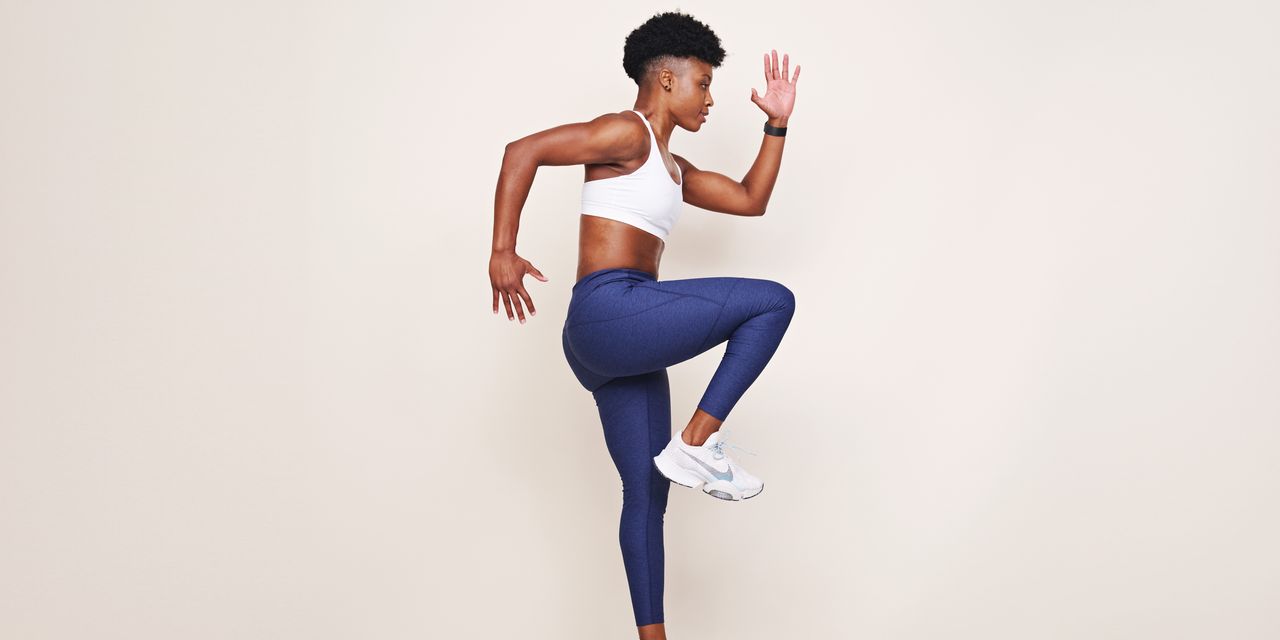Good News: You Don’t Need to Hit 10,000 Steps a Day to Be ‘Healthy’

Here’s good news if your fitness tracker is stressing you out: New research suggests you can clock way less than 10,000 steps a day and still reap some major health rewards.
That’s the major takeaway from a scientific analysis published in The Lancet Public Health. For the study, researchers analyzed data from 88 studies on step counts and health, and concluded that the “ideal” goal for a bunch of health measures should be more like 5,000 to 7,000 steps a day.
That’s because once you get into that range, you have a significantly lower risk of developing a slew of serious health conditions. Just a few examples of the perks you can expect compared to people who clock just 2,000 daily steps: a 47% lower risk of dying from any cause; a 25% lower risk of cardiovascular disease; a 37% lower risk of dying from cancer; a 14% lower risk of developing type 2 diabetes; a 38% lower risk of dementia; and a 22% lower risk of depression during that follow-up. Beyond 7,000 steps, the additional gains are pretty minimal.
Now, that’s not saying walking 10,000 steps a day is a bad goal to shoot for. The researchers do point out that 10,000 steps a day is linked with “substantially lower risks” for health conditions like we mentioned above. It’s just that, well, you can get by with a whole lot less—and who doesn’t need a little wiggle room in our packed schedules?! As the researchers wrote, “the incremental improvement beyond 7,000 steps per day was small, and there was no statistical difference between 7,000 steps per day and a higher step count for all the other outcomes.” Overall, the researchers wrote, that 7,000-step mark “might be a more realistic and achievable target.”
“It’s not that moving 10,000 steps a day is not good for health. It certainly is,” Katherine Balantekin, PhD, assistant professor in the department of exercise and nutrition sciences at University at Buffalo, tells SELF. “But for many of us, that’s a very high target, and we know that realistic goals are important for making meaningful behavior change.”
Basically, if you want to do 10,000 steps a day, more power to you. But if your rings remain not quite closed each day, no need to fret—you can still do your body a solid. Here’s what you need to know.
Moving in general is helpful for a slew of reasons.
Step count is a relatively easy measurement to track. Simple pedometers have been around for decades (in fact, that 10,000-steps-a-day goal actually came from the name of a pedometer from the 1960s—it wasn’t actually based in science!), and it’s only grown from there. Now, most phones keep some kind of log, and fitness trackers are specially designed to monitor this.
But doctors say there’s nothing inherently special about putting one foot in front of the other—movement in general is what really matters.
“Movement is important to maintain or increase muscle,” Jason P. Womack, MD, chief of the division of sports medicine and associate professor in the department of family medicine and community health at Rutgers Robert Wood Johnson Medical School, tells SELF. Muscles help to regulate glucose (a.k.a. blood sugar) in your body and can even improve insulin sensitivity, which is how well your body’s cells respond to insulin, a hormone that regulates your blood sugar, he explains. Together, that can lower your risk of developing metabolic conditions like type 2 diabetes.
But moving also increases the efficiency of your cardiovascular system. “It allows the heart to work more efficiently,” Dr. Womack says. That can lower your risk of cardiovascular disease and a bunch of other serious health conditions, he says.
Regular movement can also help to lower levels of inflammation in your body, Nathan Parker, PhD, MPH, exercise oncology researcher and assistant member in the Department of Health Outcomes and Behavior at Moffitt Cancer Center, tells SELF. That’s huge, since chronic inflammation is linked to a range of diseases, like cancer, cardiovascular issues, and autoimmune conditions.
It’s not all physical, either. On the mental health front, regular movement helps to work against some common symptoms linked with depression, like staying in more and feeling tired, Thea Gallagher, PsyD, clinical associate professor at NYU Langone Health and cohost of the Mind in View podcast, tells SELF. Movement is linked with the release of feel-good neurotransmitters dopamine and serotonin, too, which can help combat symptoms of depression, Dr. Gallagher says.
Working movement into your day doesn’t need to be complicated.
You don’t need to do intense exercise to get health benefits from movement, Nissi Suppogu, MD, cardiologist and medical director of the Women’s Heart Center at MemorialCare Heart & Vascular Institute at Long Beach Medical Center in Long Beach, California, tells SELF. “A lot of what we need to do for both physical and mental health is to keep moving,” she says.
Dr. Parker agrees. “Trying to move more and sit less day-to-day is key,” he says. Dr. Parker recommends trying to see where you can add little bursts of movement through the day, like looking at your schedule the night before and seeing where you might have time to go for a 10-minute walk, take a quick easy spin on your bike, or fit in a more traditional (even if truncated!) workout.
“There’s also something about having a goal and completing it that can make you feel a sense of mastery,” Dr. Gallagher says, which can give your mental health a boost, too.
But it doesn’t always have to be formal exercise either. It can be helpful to train your brain to look for moments when you can just move, like if you get to a restaurant before your reservation time and have a few minutes to kill, Dr. Womack says. You can even do walking “dates” with friends while you catch up to be more motivated, Dr. Gallagher points out. “It doesn’t have to be a 45-minute sweat session,” she says.
Ultimately, it’s crucial to find movements you’ll stick with, Bert Mandelbaum, MD, sports medicine specialist and co-director of the Regenerative Orthobiologic Center at Cedars-Sinai Orthopaedics in Los Angeles, tells SELF. “There is no one-size-fits-all approach,” he says. “The key is to find activities you enjoy and can incorporate into your routine.”
Related:
- Does Walking ‘Count’ as Cardio, or Do You Need to Pick Up the Pace?
- 15 Benefits of Walking That Will Make You Want to Lace Up
- Does Walking Backwards on a Treadmill Actually Do Anything?
Get more of SELF’s great fitness coverage delivered right to your inbox—for free.




